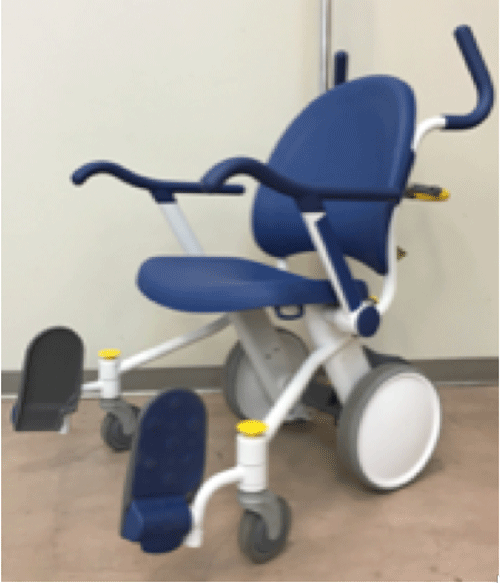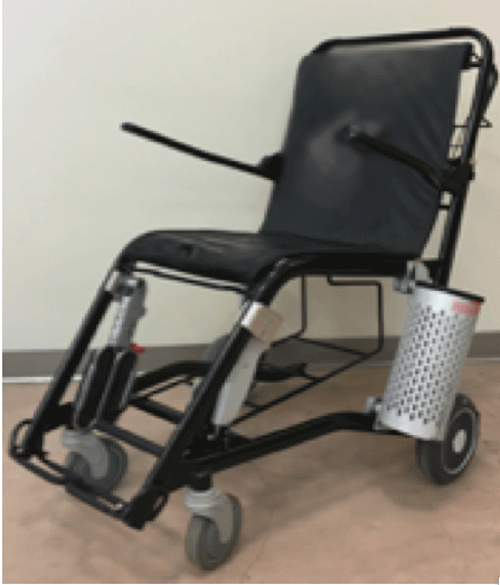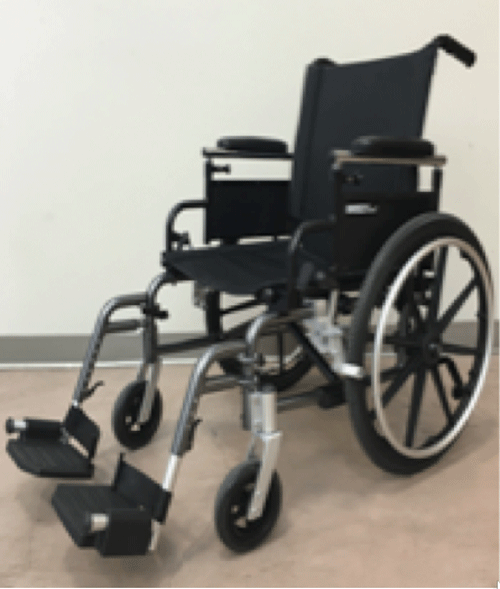Caregiver Perceptions Of Three Different Patient Transport Wheelchairs
H. Kulich1,2, S. Bass1,2, A. Koontz, PhD, RET1,2
1Human Engineering Research Laboratories, VA Pittsburgh Healthcare System, Pittsburgh, PA
2Department of Rehabilitation Science and Technology, University of Pittsburgh, Pittsburgh, PA
INTRODUCTION
Patient transport chairs (PTCs) are essential in clinical settings, as they allow individuals to access different areas of their care facilities. The most prevalent PTC in clinical settings currently is the depot-style wheelchair. Depot-style wheelchairs are appealing for hospitals primarily due to their low price point. While affordable, these chairs offer little to no adjustability for patients or caregivers, making them inappropriate for long-term use [1]. Although adjustability is not essential for short-term transport, adaptable features may aid in patient ingress/egress tasks and allow for greater ease of use and accommodation for caregivers of varying physical dimensions. Traditionally, design emphasis in PTCs has been placed in maximizing patient comfort while minimizing purchase costs. However, little consideration has been given to design concepts that minimize caregiver burden [2]. Therefore, patient transport personnel must be well qualified to anticipate and manage any complications that may arise during the transport process [3].
Studies have shown that work-related musculoskeletal injuries are particularly prevalent in the healthcare profession [4]. The highest incidence of injuries are in caregivers who manually handle patients, including those who perform patient transport tasks [5]. Caregivers experience a variety of occupational hazards that increase their risk of developing musculoskeletal overuse injuries including repetitive flexion and extension of the elbow, trunk, and knee, prolonged or excessive handling activities, and extended work schedules [3]. Lower back pain is the most frequently documented work-related complaint amongst caregivers, with shoulder and upper extremity injuries also reported [6].
Two PTCs: 1) Stryker® Prime TC and 2) Staxi® Medical Chair have been developed specifically to minimize caregiver strain and musculoskeletal burden during patient transport in hospitals and clinics. Updating the design of these chairs to accommodate both the users and the caregivers may lead to decreased caregiver injury which can adversely impact hospital staffing and the financial burden on employers [3]. The purpose of this study is to compare caregiver perceptions of the the Stryker® Prime TC, Staxi® Medical Chair, and depot-style chair (Breezy® Ultra 4 Wheelchair) while performing transport tasks in a simulated clinical environment. It was hypothesized that transport chairs with design features to accommodate caregivers will have higher ratings for mobility tasks than the traditional depot style wheelchair.
METHODS
The study received approval from the VA Pittsburgh Healthcare System’s Institutional Review Board. Twenty-three participants were recruited and signed informed consent forms before any testing procedures occurred. Inclusion criteria were defined as: 1) At least two years’ experience with patient transport and 2) 18 years of age or older. Subjects were excluded from the study if they had a recent history of back pain or injury that could be aggravated by bending over or pushing a wheelchair.
Experimental Protocol
Prior to testing procedures, participants completed a questionnaire that collected demographics information such as age, height, weight and gender. Additionally, questions were answered about occupation and years of work related experience.

Prior to performing tasks, subjects were given a brief overview of the features specific to each PTC, and were allotted sufficient time to become familiar with its function. Chair order between subjects was randomized. Participants performed a series of tasks designed to reflect routine clinical work-related transport duties of caregivers to test PTC functionality and maneuverability. Each chair was loaded with a 50th percentile male test dummy weighing 185 pounds for all transport tasks. Fourteen transport-tasks were completed for each chair in an obstacle course simulating a clinical setting (Figure 2). Tasks included straightaway sections, a series of, 90°, and 180° turns, and a 5° inclined and declined ramp. Additional tasks that were completed outside of the course included pushing the PTCs through doors, over carpet, and into/out of an elevator. Time for rest between chair conditions was provided as needed. Straightaway walking tasks were performed twice 1) at a self-selected pace and 2) with a walking pace synchronized with a metronome set at 60 beats per minute. Directly after completing all transport tasks for each chair, participants completed a survey with questions that asked them how easy it was to complete each task. Subjects responded to each question by marking a line through a 10 cm long visual analog scale anchored by “0” extremely difficult to complete and “10”, extremely easy to complete. Space was provided at the end of the survey to report additional comments or observations.
Statistical Analysis
A one way Repeated measures ANOVA was performed for each task with a level of significance at p < 0.05. Significant differences were further analyzed using Bonferoni post-hoc tests. All statistical analysis was performed using SPSS Version 24 (SPSS Inc, Chicago).
RESULTS
Twenty-three participants were enrolled in the study and included 14 women and 9 men. The group mean (± standard deviation) of age, height, weight, and years of clinical transport experience were 39.4 ± 18 years, 67.1 ± 4.2 inches, 169.3 ± 36.5 lbs and 7.4 ± 8.1 years, respectively. The study population consisted of physical therapists, occupational therapists, nurses, aides, and patient transporters with a wide range of transport experience.
User Satisfaction Results
Mean scores, standard deviations, and significant p-values for mobility tasks can be seen below in Table 1. Both the Prime TC and Staxi Medical Chair had high usability scores across tasks, with most scores being close to 10. Subjects rated the Stryker Prime TC and Staxi Medical Chair higher for 90⁰ turns forward, moving sideways next to an object, repositioning armrests and 45⁰ turning when compared to the depot style wheelchair (p<0.05). The Prime TC was rated higher for 90⁰ turns backwards when compared to the depot style chair (p=0.017). The Staxi Medical Chair was rated higher than the depot chair for forward movement on a level surface (10 m and 30 m), maneuvering in an elevator and repositioning footrests (p<0.05). Clinicians rated the application and release of the brakes higher for the Prime TC when compared to both the Staxi Medical Chair and the depot-style chair (p<0.05). No differences were seen for moving up and down a 5⁰incline, going through a door, or moving across a carpet between the three chairs.
| Prime TC | Staxi | Depot-style | p-value | |
|---|---|---|---|---|
| Q1. Forward on level surface (10 m) | 9.1 ±1.0 | 9.1 ±1.0* | 8.1 ±1.8* | 0.027* |
| Q2. Forward on level surface (30 m) | 9.2 ±0.8 | 9.1 ±1.2* | 8.2 ±1.7* | 0.034* |
| Q3. 90⁰ turn forward | 8.8 ±1.4† | 8.7 ±1.3* | 7.3 ±2.3*† | 0.040*† |
| Q4. 90⁰ turn backward | 8.8 ±1.3† | 8.5 ±1.4 | 7.1 ±2.4† | 0.017† |
| Q5. 180⁰ turn in a tight space | 8.5 ±1.7 | 8.3 ±2.0 | 7.0 ±2.6 | |
| Q6. Moving sideways next to an object | 8.5 ±1.5† | 8.2 ±1.7* | 6.1 ±2.4†* | 0.003† 0.004* |
| Q7. Opening, going through, and closing a door | 8.1 ±2.2 | 7.6 ±2.6 | 7.0 ±2.4 | |
| Q8. Maneuvering in an elevator | 8.7 ±1.4 | 8.6 ±1.3* | 7.6 ±1.7* | 0.042* |
| Q9. Apply and release brake | 9.7 ±0.5†* | 8.8 ±1.5* | 7.7 ±2.1† | 0.023* 0.001† |
| Q10. Reposition armrests | 9.4 ±0.7† | 9.0 ±1.8* | 7.8 ±2.3†* | 0.005† 0.031* |
| Q11. Reposition footrests | 9.0 ±2.1 | 9.2 ±1.0* | 7.6 ±1.9* | 0.005* |
| Q12. Move up a 5⁰ incline | 7.3 ±1.9 | 6.6 ±2.3 | 6.1 ±2.2 | |
| Q13. Move down a 5⁰ incline | 7.5 ±2.2 | 7.4 ±2.7 | 6.7 ±2.1 | |
| Q14. Move across a thick carpet | 9.0 ±1.2 | 8.4 ±1.7 | 8.0 ±1.8 | |
| Q15. 45⁰ turn | 9.1 ±1.0† | 8.9 ±1.6* | 7.3 ±1.8†* | 0.001† 0.013* |
Open Ended Survey Responses and Comments
Examples of the open-ended user feedback can be seen in Table 2. Subjects reported liking the projecting handles, maneuverability on smooth surfaces, and braking on the Prime TC, but commented on a reduced maneuverability on ramps and in tight spaces. Subjects liked the maneuverability of the Staxi Medical Chair, but disliked the braking system. Both the Prime TC and Staxi Medical Chair received more favorable feedback than the traditional depot-style wheelchair.
Table 2. Open-ended user feedback for the Stryker Prime TC, Staxi Medical Chair, and Depot-style chair
| Stryker Prime TC |
| “I like the distance afforded by the projecting handles. I can use a more natural stride without being concerned about kicking the chair.” |
| “It glides and maneuvers very easily” |
| “Prime TC is more suitable in smooth surface or not so steep ramp as well as with lots of space and room to maneuver. But it fares poorly when being on a ramp” |
| It is very easy to apply the brakes on the back of the chair, and the degree to move around. However, I think it is semi-difficult to move around tight spaces. |
| “This wheel chair felt much more natural to push. The brakes are very convenient. The access to the foot rests are also very nice.” |
| Staxi Medical Chair |
| “Very easy to push/turn/move with the Staxi. The only negative is holding the brake bar for longer” |
| “Staxi is really easy to maneuver… but the operator needs to be attentive and apply full strength to the brake when moving forward or backward” |
| “Because you have to hold in the brake bar while traveling its very hard on the hands… tension is in my wrist after the test drive.” |
| Depot-style Chair |
| “This wheelchair is traditional. But since the handles are in a lower position, so it requires a taller person to lean forward all the time and apply force and strength just to move the wheelchair forward.” |
| “This chair is lower and I could see it causing back pain/strain for caregivers.” |
| “This chair puts more strain on your muscles while pushing the patient. It also took a lot of strength to turn the wheel chair with the patient in the chair.” |
| “Didn’t particularly like this chair, its heavier and smaller.” |
DISCUSSION
The majority of subjects gave both the Stryker Prime TC and Staxi Medical Chair high ratings for mobility tasks, reporting that the devices were easier to use than traditional depot-style wheelchairs. The majority of differences in caregiver ratings were seen between either the Prime TC and depot-style chair or the Staxi Medical Chair and depot-style chair. Subjects reported that the traditional depot-style wheelchair required more effort to push, increasing strain on the caregivers during mobility tasks. While the design of both the Prime TC and Staxi Medical Chair differ, they both include features to reduce caregiver burden. Caregivers ranked both ergonomic transport chairs on the higher end of the spectrum (near 10) despite the few negatives they noted in their reviews.
When comparing the two ergonomic transport chairs, the one statistical difference found concerned the application and release of the braking system. Subjects preferred the braking operations of the Prime TC, which was controlled by activating a foot pedal, to the braking of the Staxi Medical Chair, which involved releasing the handlebar. While releasing the bar to brake the chair does not require much effort, subjects reported that it was tiring having to hold the handlebar in (which deactivates the braking) during movement. Subjects noted in the open ended feedback some difficulty in maneuvering the Stryker Prime TC on inclines and in tight spaces. Two main factors that impact maneuverability include weight of the device and overall device dimensions. As the overall device length and width of the Prime TC was similar to the Staxi, the comments may be due to the increased weight of the Prime TC in comparison to the other two chairs.
CONCLUSION
The caregiver feedback obtained in this study suggests that ergonomic PTCs may reduce caregiver burden during patient transport tasks. By customizing PTCs to caregivers, a more enjoyable transport experience can be provided to both the caregiver and the patient. Ergonomic designs may reduce injury risk to caregivers and their patients, increasing safety to both populations during transport in clinical settings.
REFERENCES
[1] Karmarkar AM, et al. Demographic profile of older adults using wheeled mobility device. J Aging Res: 2011.
[2] Lee SY, Kim SC. Comparison of Shoulder and Back Muscle Activation in Caregivers According to Various Handle Heights. J Phys Ther Sci: 1231-1233. Oct 2013.
[3] Kulshrestha, A., & Singh, J. (2016). Inter-hospital and intra-hospital patient transfer: Recent concepts. Indian
Journal of Anaesthesia, 60(7), 451. doi:10.4103/0019-5049.186012
[4] Oranye O, Wallis B, Roer K. Do Personal Factors or Types of Physical Tasks Predict Workplace Injury? Workplace Health Saf 64: 141-151. April 2016.
[5] Kothiyal K, Yuen TW. Muscle strain and perceived exertion in a patient handling with and without a transferring aid. Occupational Ergonomics (4): 185-197. 2004.
[6] Daikoku R, Saito Y. Differences between novice and experienced caregivers in muscle activity and perceived exertion while repositioning bedridden patients. J Physiol Anthropol 27(6): 333-9. Nov 2008.
ACKNOWLEDGEMENTS
Funding was provided by the Stryker® Corporation through the VA Research Foundation, and by the National Institutes of Health through Grant Number UL1TR001857. The contents of this paper do not represent the views of the Department of Veterans Affairs or the United States Government.


